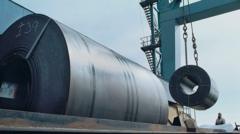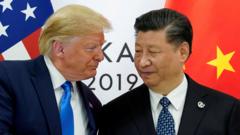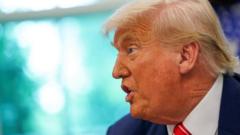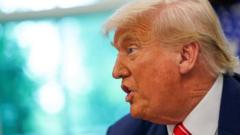President Donald Trump has officially raised tariffs on steel and aluminium imports from 25% to 50%, a significant escalation aimed at bolstering the American steel industry. This move, effective immediately, marks the second increase in tariffs this year, stirring concern among businesses in various sectors and prompting fears of retaliation from international trade partners. While Trump argues that such measures will safeguard domestic producers, critics warn of potential chaos in supply chains and increased costs for manufacturers reliant on imported metals.
Trump Increases Tariffs on Steel and Aluminium to 50%

Trump Increases Tariffs on Steel and Aluminium to 50%
The US President's decision raises concerns over economic impact and international trade relations.
In a world already accustomed to uncertainty, many companies were taken aback by the suddenness of this announcement. Just hours before it was made, industry stakeholders expressed skepticism, hoping the proposed tariffs might not come to pass. Specifically, Rick Huether, CEO of Independent Can Co, voiced his worries about how these tariffs would impact production costs and potentially drive customers to substitute materials. Trump's previous tariff actions had already led to pauses in investments and subsequent price hikes in various sectors, adding to the existing chaos in steel-related businesses.
Despite the dramatic hike, some nations have successfully negotiated exceptions. Notably, the UK maintains a 25% tariff on its steel and aluminium exports to the US due to ongoing trade discussions. This relief, however, comes amid broader concerns that these tariff increases may stimulate similar retaliatory measures from other countries and harm U.S. economic interests.
As of May, there had been minimal changes in raw steel production and imports in the US, but projections indicate a more substantial fallout from this recent 50% tariff escalation, particularly for smaller manufacturers like Drill Rod & Tool Steels. With impending costs estimated to double, one business owner reported a dramatic spike in tariffs leading to a substantial increase in expenses, compelling his company to reconsider pricing strategies and potentially cut worker hours.
On an international scale, the European Union and Canada have voiced their intentions to respond with their own tariffs on American goods, countering the aggressive measures taken by the US. This escalation could lead to tense negotiations as global markets react to the shifting trade landscape. As businesses brace for impending slowdowns and price increases, economists caution that these tariffs could ultimately do more harm than good, potentially leading to significant job losses outside of the steel sector.
As U.S. firms navigate these turbulent waters, the specter of increased tariffs looms large—a reality that could reshape not just the steel industry, but also the larger U.S. economy in the months ahead.
Despite the dramatic hike, some nations have successfully negotiated exceptions. Notably, the UK maintains a 25% tariff on its steel and aluminium exports to the US due to ongoing trade discussions. This relief, however, comes amid broader concerns that these tariff increases may stimulate similar retaliatory measures from other countries and harm U.S. economic interests.
As of May, there had been minimal changes in raw steel production and imports in the US, but projections indicate a more substantial fallout from this recent 50% tariff escalation, particularly for smaller manufacturers like Drill Rod & Tool Steels. With impending costs estimated to double, one business owner reported a dramatic spike in tariffs leading to a substantial increase in expenses, compelling his company to reconsider pricing strategies and potentially cut worker hours.
On an international scale, the European Union and Canada have voiced their intentions to respond with their own tariffs on American goods, countering the aggressive measures taken by the US. This escalation could lead to tense negotiations as global markets react to the shifting trade landscape. As businesses brace for impending slowdowns and price increases, economists caution that these tariffs could ultimately do more harm than good, potentially leading to significant job losses outside of the steel sector.
As U.S. firms navigate these turbulent waters, the specter of increased tariffs looms large—a reality that could reshape not just the steel industry, but also the larger U.S. economy in the months ahead.





















